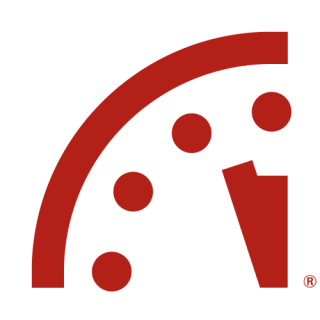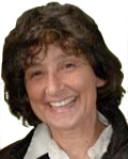Environment
The Doomsday Clock and Me
3 Minutes to Midnight, and the End of the World
Posted February 7, 2015

I grew up in Chicago during the 1950s, and the Bulletin of the Atomic Scientists sat prominently on our coffee table as long as I can remember. My father, Morris A. Lipton, told me he had been given the choice of the Manhattan Project or Chemical Warfare during World War II, and he chose Chemical Warfare, to his regret. Instead of designing the atomic bomb, he designed chemical weapons. In fact, he called himself the “Adolf Eichmann of rats” because he killed so many, as well as sheep, goats and other animals. My dad knew Enrico Fermi and many other Chicago physicists, and he was envious that the fruit of their labors was so glamorous.
Nevertheless, from its inception in 1945, my father subscribed to the Bulletin, and he understood that nuclear war would mean the end of human life, and maybe life on earth. I clearly recall the night of September 22, 1959, when I was 8 years old. The Fire Commissioner of Chicago, Robert Quinn, (who was also head of the Civil Defense Corps) decided to celebrate the victory of the Chicago White Sox against the Cleveland Indians by sounding the air-raid sirens at 10:30 PM. The Alert blared for a full 5 minutes, indicating that an air attack was expected, but not for at least 31 minutes. I was at a party with my parents. When the siren rang, the room became quiet and many people went to look out the windows. I asked my father what was happening, and he said, “This may be the end of the world.”
So there is no doubt that Daddy knew the potentially lethal consequences of nuclear weapons, and yet he celebrated them also, maybe for seeming to end to the war (although most authorities believe now that the war would end in a few weeks anyway) or maybe because the science behind the bombs was so elegant, so “technically sweet” as they said. I suppose the science behind the development of chemical weapons was also elegant. I never heard my father express remorse over helping to develop weapons that are now considered crimes against humanity.
The Bulletin of the Atomic Scientists started in 1945 as a newsletter by a group of Chicago physicists. The Federation of Atomic Scientists evolved from that core group, and the newsletter became a magazine in 1947, featuring its now iconic image of the Doomsday Clock, the scientists’ best estimate of the risk of nuclear war. On the first edition, the hands of the clock were at 7 minutes to midnight, with midnight meaning the end of civilization. In 1953, after the testing of the first H Bomb, the hands went to 2 minutes to midnight. During the Reagan era, the hands were at 3 minutes to midnight, but after the end of the Cold War and the fall of the Berlin Wall, they were reset to 17 minutes to midnight, the safest that the scientists have felt since the development of nuclear weapons.
Since 2012, the clock has been at 5 minutes to midnight. On January 22, 2015, the Bulletin announced a new setting, 3 minutes to midnight. The Doomsday clock now incorporates climate change and technology into its calculation of extinction. The hands of the clock were moved because of accelerating climate change coupled with inadequate international attention to greenhouse gas emission; nuclear modernization programs in the US, Russia, and other states; stalled reductions in numbers of warheads (there are currently 16,300, most of them bigger than the two that destroyed Hiroshima and Nagasaki); and escalating tensions in Europe and the Middle East (Ukraine, Syria, and Iraq) as well as in the South China Sea, all indicating that the threat of nuclear war and the collapse of civilization is the same as in 1984, at the height of the Cold War.
Little known to most Americans, President Obama - who won the Nobel Peace Prize in 2009 - is planning to “modernize” the entire US nuclear arsenal, at the cost of about a trillion dollars over the next 30 years. Instead of abolishing nuclear weapons, which he endorsed at the start of his presidency, he now wants to enlarge and elaborate the whole system. There has been no update of deterrence theory, the idea that only the threat of global annihilation prevents nuclear war, even though recent calculations estimate that even a “limited nuclear war” would cause the deaths of two billion people due to famines and climate change alone.
In 1961, a group of young doctors at Harvard formed Physicians for Social Responsibility (PSR), which gained prominence with its article, “The Medical Consequences of Thermonuclear War,” published on May 31, 1962. It analyzed the effects of one 20 megaton bomb on Boston. That horrific data played a large role in catalyzing the Partial Nuclear Test Ban Treaty (1963) and Nuclear Non-Proliferation Treaty (1968). The latter not only called for limits on the global expansion of nuclear weapons to non-nuclear states, but the signatories (including the US) committed themselves to active measures eliminating them altogether.
In response to the Reagan Administration’s initially cavalier attitude toward nuclear war, PSR joined with other medical groups worldwide, forming the International Physicians for the Prevention of Nuclear War, which was awarded a Nobel Peace Prize in 1985. Unfortunately, despite the evident success of some basic human sanity or good luck (nuclear war has not happened yet!), the countries that signed the various treaties failed to keep their promises. The arsenals have indeed shrunk, from a high of more than 50,000 weapons to only 16,300. But more countries than ever have nuclear bombs: the Big Five (US, Russia, Great Britain, France, and China) have been joined by India, Pakistan, Israel and, most recently, North Korea, with, Iran knocking on the door. Russia and the USA have already begun to "modernize".
I joined PSR in 1979, and spent more than a decade devoted to PSR, lecturing about the medical and psychiatric consequences of nuclear war and the nuclear arms race. My husband and I wrote two books about nuclear war. While we were raising small children and trying to have “normal lives,” our house was filled with photos of blasts, burns, and radiation. But when the Berlin Wall came down in1991, and the hands of The Clock were at 17 minutes to midnight, we gratefully put that topic down, trying to enjoy life and its ordinary pleasures and problems. Unfortunately, the risk is back. The threat has grown again. At the end of his novel, The Plague, Albert Camus pointed out that although an epidemic of plague eventually burns out, the rats always return. The rats are coming back now. The insane drive to control the world, its markets, religions, and resources has led to a resurgence of nuclear ambitions with modern expensive weapons of mass destruction.
The only way to prevent a nuclear holocaust is to ban nuclear weapons altogether, and to invest money in technical means to verify that others are not being developed, tested, or deployed. The Clock at 3 minutes to midnight means that we are in dire danger of extinction, along with the rest of the biosphere; it is very bad news indeed.
So I sent in my subscription to the Bulletin of the Atomic Scientists, yet again, and will spend my remaining days and evenings working with PSR, trying to keep my children from having to tell their children, “I think this means the end of the world.”




